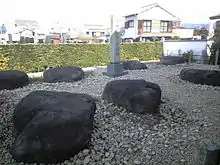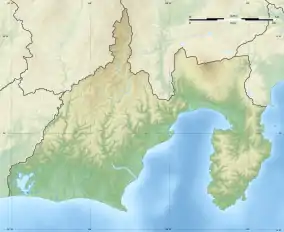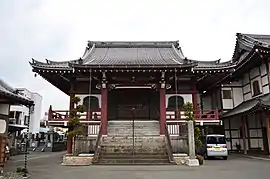Izu Kokubun-ji
Izu Kokubun-ji (伊豆国分寺) is a Buddhist temple located in what is now the city of Mishima, Shizuoka, Japan. It is the modern successor of one of the provincial temples established by Emperor Shōmu during the Nara period (710 – 794) for the purpose of promoting Buddhism as the national religion of Japan and standardising control of Yamato rule over the provinces.[1] The foundation stones for the seven-story pagoda of original temple was designated as a National Historic Site by the Japanese government in 1956. [2]
| Izu Kokubun-ji | |
|---|---|
伊豆国分寺 | |
 Foundation Stones from the Nara period pagoda | |
| Religion | |
| Affiliation | Buddhist |
| Deity | Shaka Nyōrai |
| Rite | Nichiren sect |
| Status | functional |
| Location | |
| Location | Izumi-chō 12-31, Mishima-shi, Shizuoka 411-0037 |
| Country | |
 Shown within Shizuoka Prefecture  Izu Kokubun-ji (Japan) | |
| Geographic coordinates | 35°7′12.28″N 138°54′35.1″E |
| Architecture | |
| Founder | Emperor Shomu |
| Completed | 741 |

History
Izu Kokubun-ji was founded in 741 as the provincial temple of Izu Province. It was converted at some uncertain time to the Shingon sect, and was burned down repeatedly in the incessant battles between the forces the Takeda clan and the Odawara Hōjō clan during the Sengoku period. In the early Edo period, it converted to the Nichiren sect and was completely rebuilt; however, these buildings were all destroyed by the 1855 Ansei Edo earthquake and the site was abandoned.
In 1923, the temple was rebuilt again as Shoren-ji (称蓮寺), and was renamed to Izu Kokubun-ji in 1954. Archaeological investigations were conducted in 1956. The foundations of the South Gate, Central Gate, Kon-dō and Kōdō (Lecture Hall) were discovered, as wells as the foundations of the surrounding cloister. The layout of the buildings was in accordance with the standardized "Shichidō garan" formation, similar to Tōdai-ji in Nara, upon which the kokubunji temples were based.
Outside of the main complex, eight foundation stones of the original Nara-period Kokubun-ji’s pagoda were uncovered, immediately behind the present temple’s Hondō. The foundation stones were made of tuff, and duding from the size and layout of the foundation, the pagoda was seven-stories high with a height of 60-meters.
The temple is located approximately one kilometer south of modern Mishima Station on the Tōkaidō Main Line railway.
References
- "Kokubunji". Encyclopedia of Japan. Tokyo: Shogakukan. 2012. Archived from the original on 2007-08-25. Retrieved 2012-05-04.
- "伊豆国分寺塔跡" (in Japanese). Agency for Cultural Affairs.
External links
![]() Media related to Izu Kokubunji at Wikimedia Commons
Media related to Izu Kokubunji at Wikimedia Commons
- Mishima City home page(in Japanese)
- Shizuoka Prefecture official site(in Japanese)